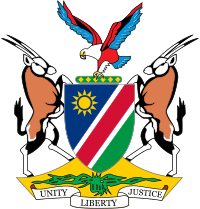System of government
Birth of the Republic
The road to Namibia’s Independence came through a long and protracted struggle for liberation by the people of Namibia led and organised through SWAPO and supported by the international community. As from April 1989, the United Nations Resolution 435 of 1978 was finally implemented paving the way for the UN-supervised November 1989 elections to create the Constituent Assembly, which in effect decided the legal basis of the Namibian State and its institutional structures.
Constituent Assembly
The Constituent Assembly:
- Drafted the Constitution of the Republic of Namibia and adopted it on the 9th February 1990;
- Determined the date of Independence as 21 March 1990;
- Elected the President, His Excellency Dr. Sam Nujoma, who in turn appointed the first Cabinet.
- The Chairperson of the Constituent Assembly, Hon. Hage Geingob, was nominated by the President as the Prime Minister.
- The Constituent Assembly Members and the addition of six non-voting Members nominated by the President, constituted the first National Assembly.
- The voting Members of the National Assembly elected amongst them Hon. Dr. Mosè P. Tjitendero as the Speaker and Hon. Dr. Zephania Kameeta as the Deputy Speaker.
- After decades of oppression, war and several years of endless negotiations, Namibians had at last taken control of their country’s destiny and the Republic of Namibia was born on 21 March 1990.
The Constitution
The constitution promulgates a multiparty democracy with fundamental rights and freedoms, a mixed economy and states that foreign investment should be encouraged. It also follows the principle of a separation of powers and subject to checks and balances, whereby government is divided into three branches, the executive, the legislature and the judiciary.
Structure of Government
The President is the Head of State and Government. He or She is also the Commander-in-Chief of the Namibian Defence Force. Executive power is vested in the President and Cabinet. He or she is elected by a popular vote for a term of five years with a maximum of two terms and signs the bills passed by both houses of the legislature into law.
Cabinet
- President: Dr. Hage Geingob
- Vice President: Nangolo Mbumba
- Prime Minister: Saara Kuugongelwa-Amadhila
- Deputy Prime Minister & Minister of International Relations and Cooperation: Netumbo Nandi-Ndaitwah
- Minister of Presidential Affairs: Immanuel Ngatjizeko
- Minister of Agriculture, Water and Forestry: Alpheus !Naruseb
- Minister of Defence: Penda Ya Ndakolo
- Minister of Economic Planning and Director General of the National Planning: Obeth Kandjoze
- Minister of Education, Arts and Culture: Katrina Hanse-Himarwa
- Minister of Environment and Tourism: Pohamba Shifeta
- Minister of Finance: Calle Schlettwein
- Minister of Fisheries and Marine Resources: Bernhard Esau
- Minister of Gender Equality and Child Welfare: Doreen Sioka
- Minister of Health and Social Services: Dr. Kalumbi Shangula
- Minister of Home Affairs and Immigration: Frans Kapofi
- Minister of Higher Education, Training and Innovation: Dr. Itah Kandjii-Murangi
- Minister of Industrialization, Trade and SME Development: Tjekero Tweya
- Minister of Information and Communications Technology: Stanley Simataa
- Minister of Justice: Sackeus Shanghala
- Minister of Labour, Industrial Relations and Employment Creation: Erkki Nghimtina
- Minister of Land Reform: Uutoni Nujoma
- Minister of Ministry Mines and Energy: Tom Alweendo
- Minister of Poverty Eradication and Social Welfare: Bishop (Ret.) Zephania Kameeta
- Minister of Public Enterprises: Leon Jooste
- Minister of Safety and Security: General (Ret.) Charles Namoloh
- Minister of Sport, Youth and National Service: Erastus Utoni
- Minister of Urban and Rural Development: Peya Mushelenga
- Minister of Works and Transport: John Mutorwa
- Attorney General: Dr. Albert Kawana
- Secretary to Cabinet: George Simataa
Legislative
Namibia has a bicameral legislature consisting of the National Assembly and the National Council.
The 72 voting member National Assembly is elected for a term of five years on the basis of proportional representation and “Westminster-type” rules apply to the procedures of the house. The President appoints an additional six non-voting members.
The National Council was formed in accordance with chapter eight of the Namibian Constitution, on February 1993, after the regional elections held in November 1992. The Council is made up of 2 representatives, elected every six years, drawn from the 13 Regional Councils. It reviews legislation proposed by the National Assembly and refers bills back or suggests amendments before they receive presidential assent and become law.
Judicial
The judiciary includes the Supreme Court (headed by the Chief Justice), the High Court (headed by the Judge President) and the Lower Courts. All the courts are independent and subject only to the Constitution. Judges are appointed by the President on the recommendation of the Judicial Service Commission.
